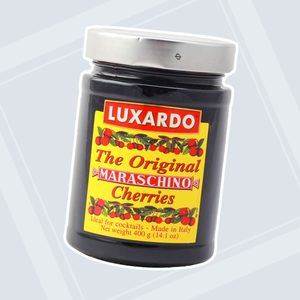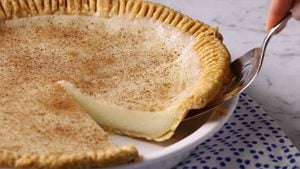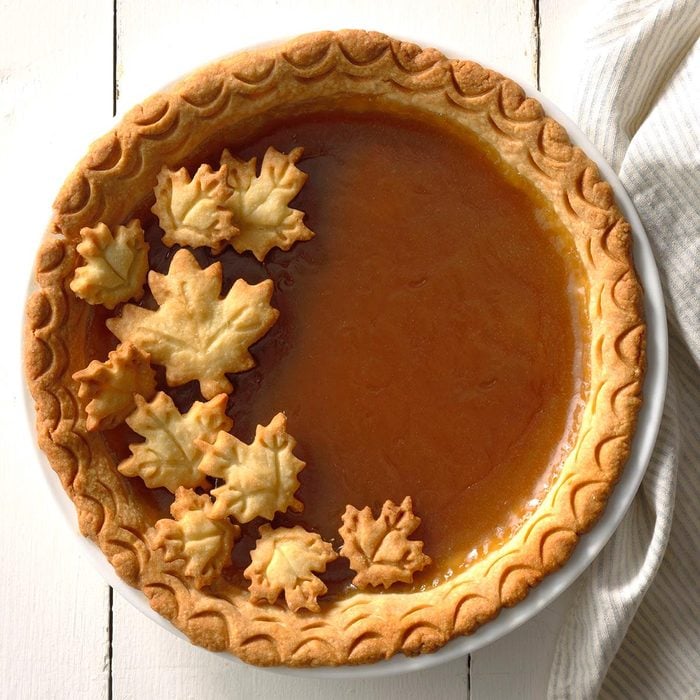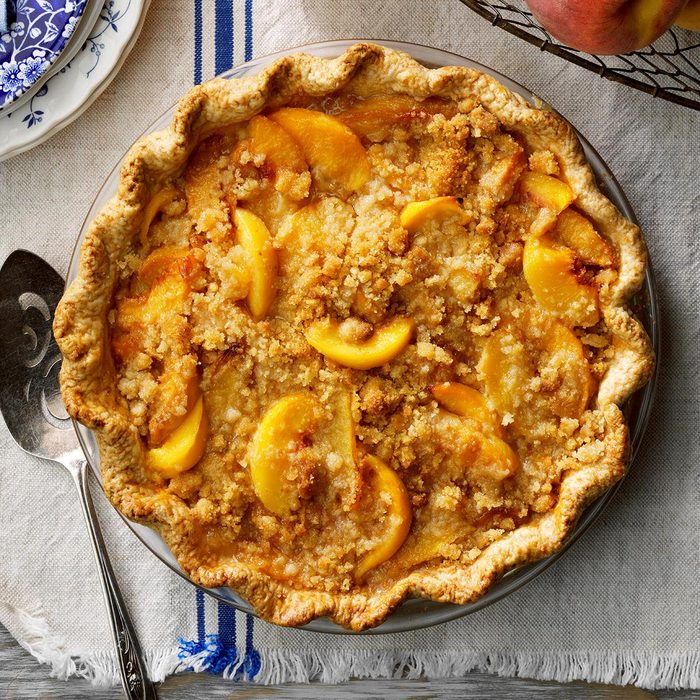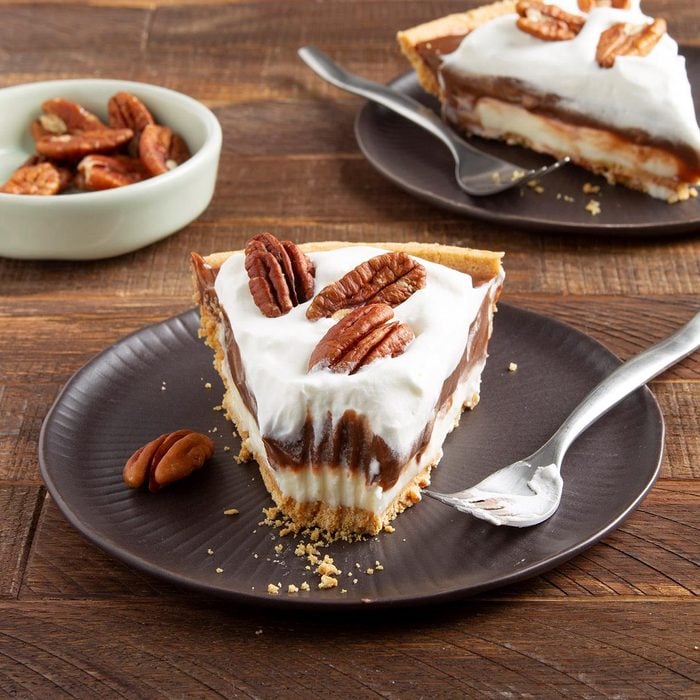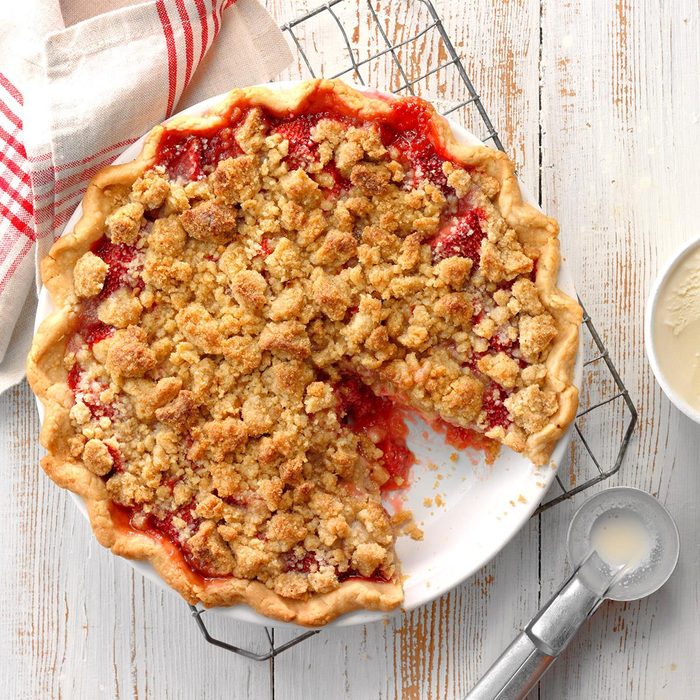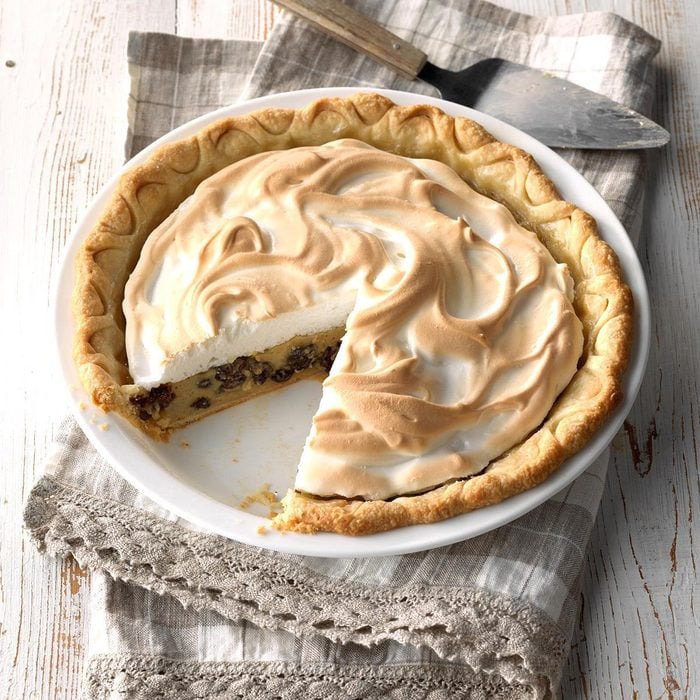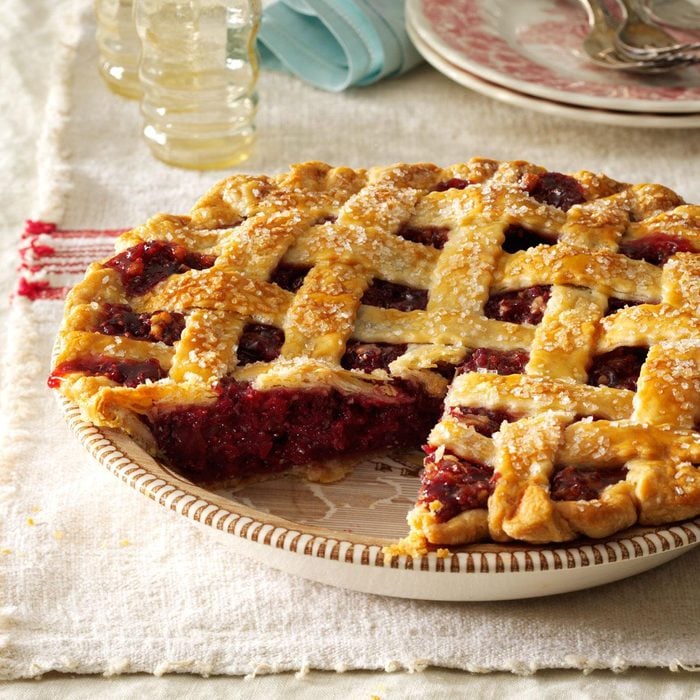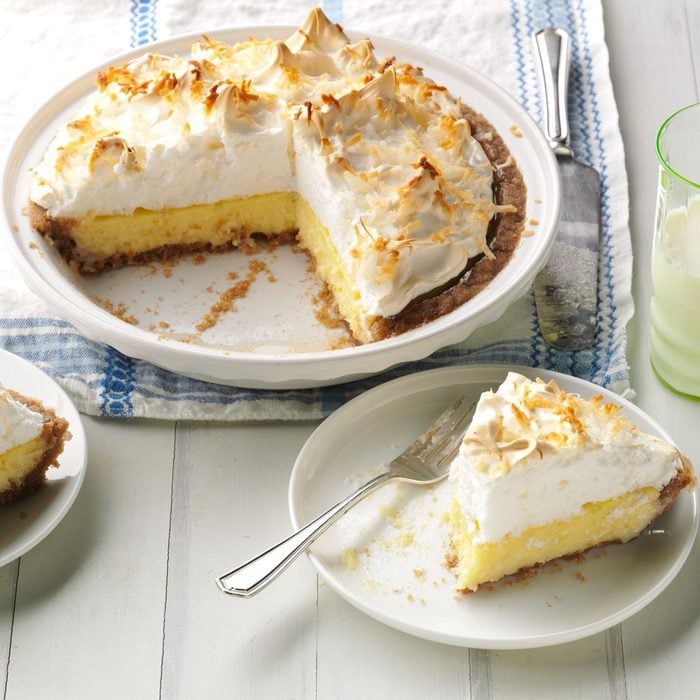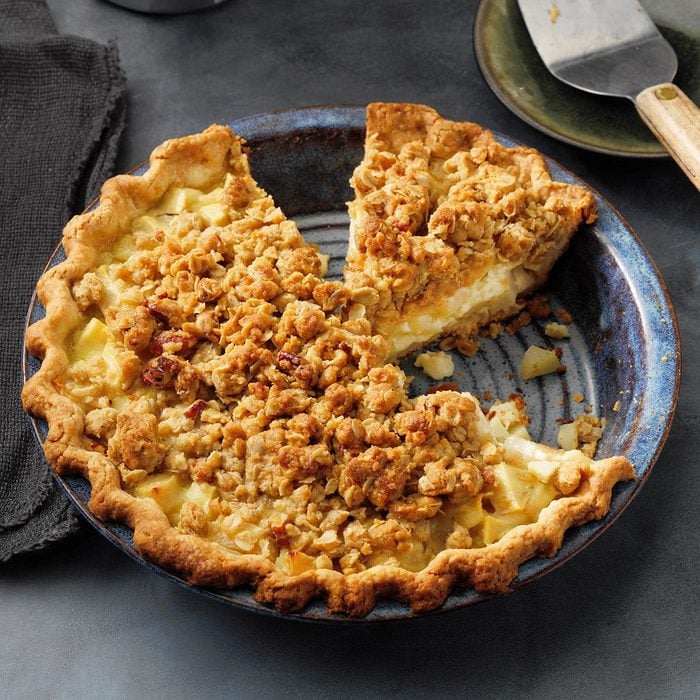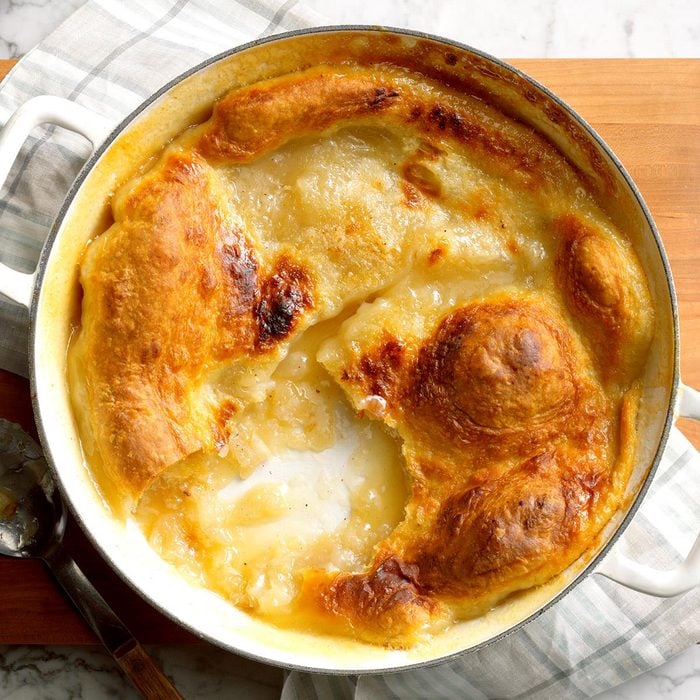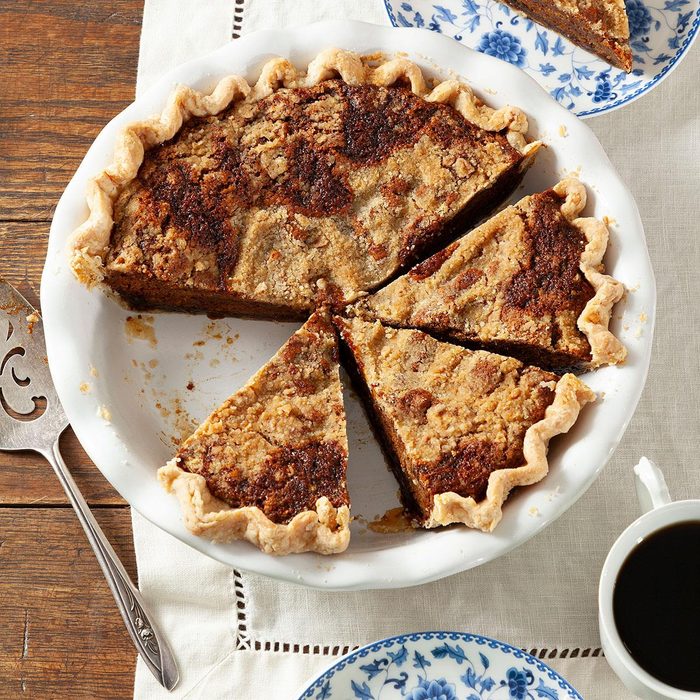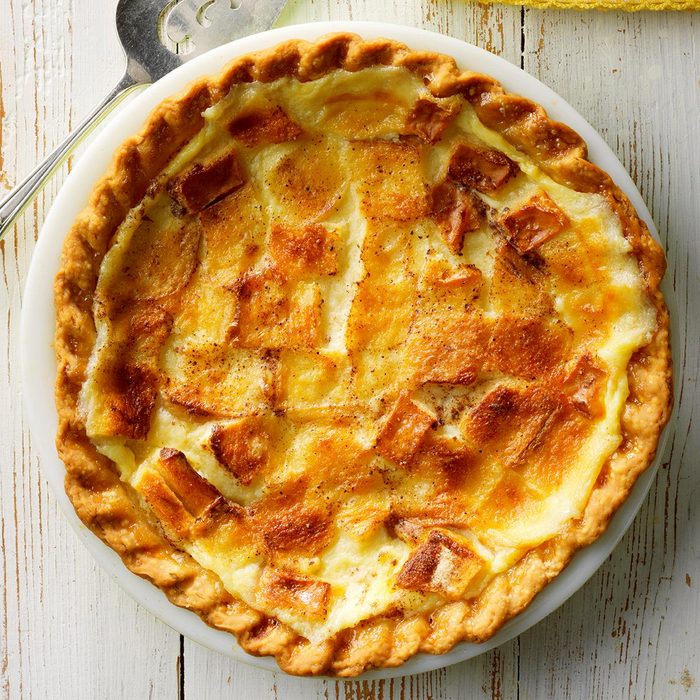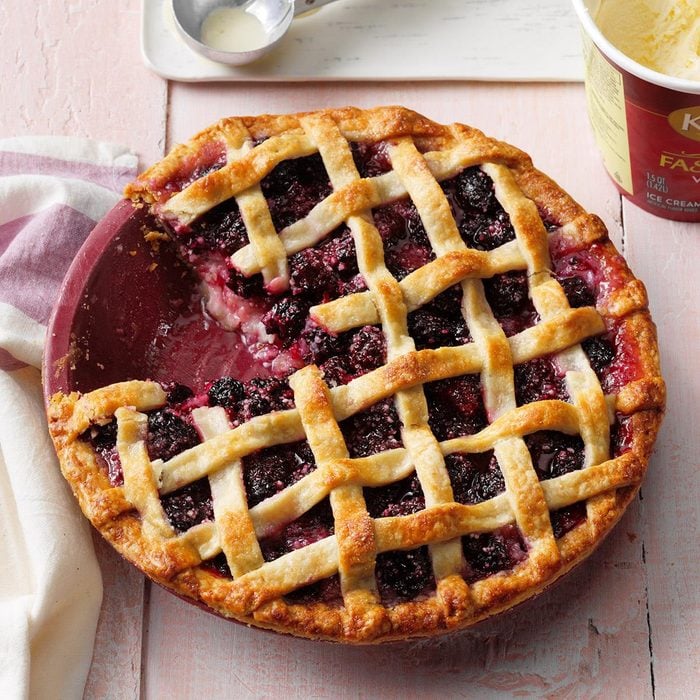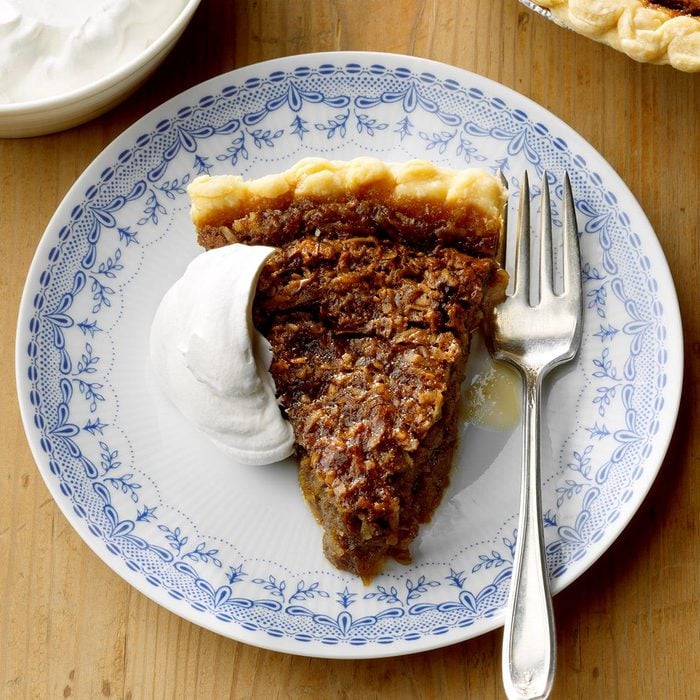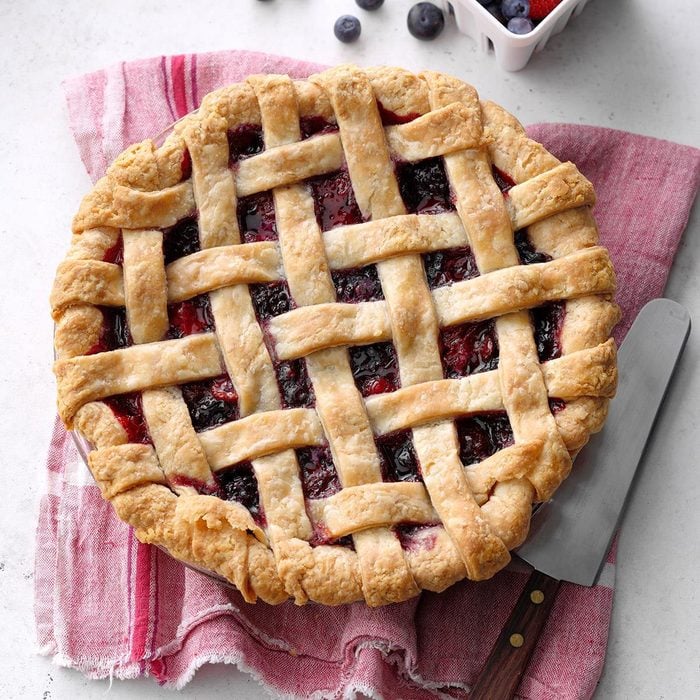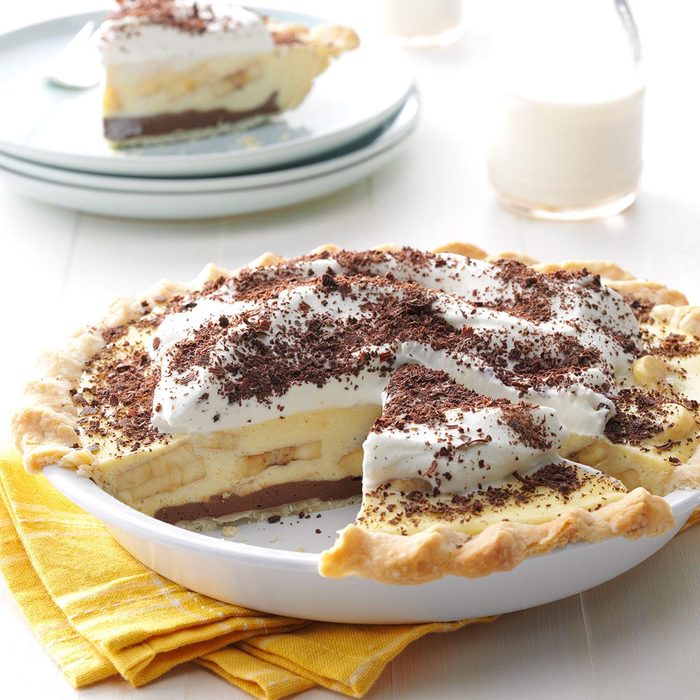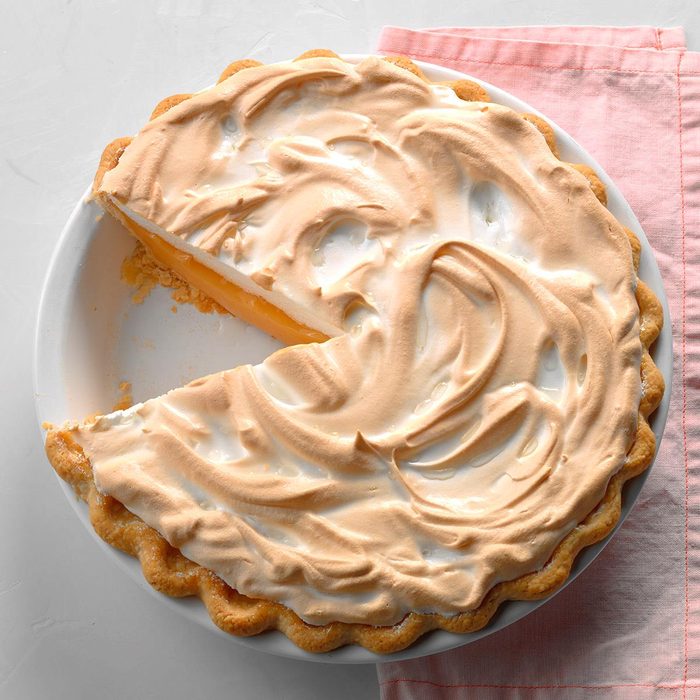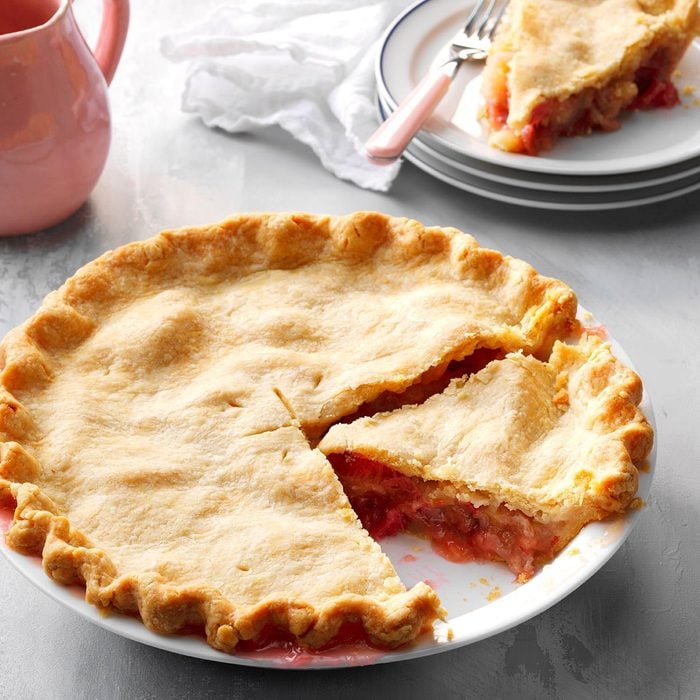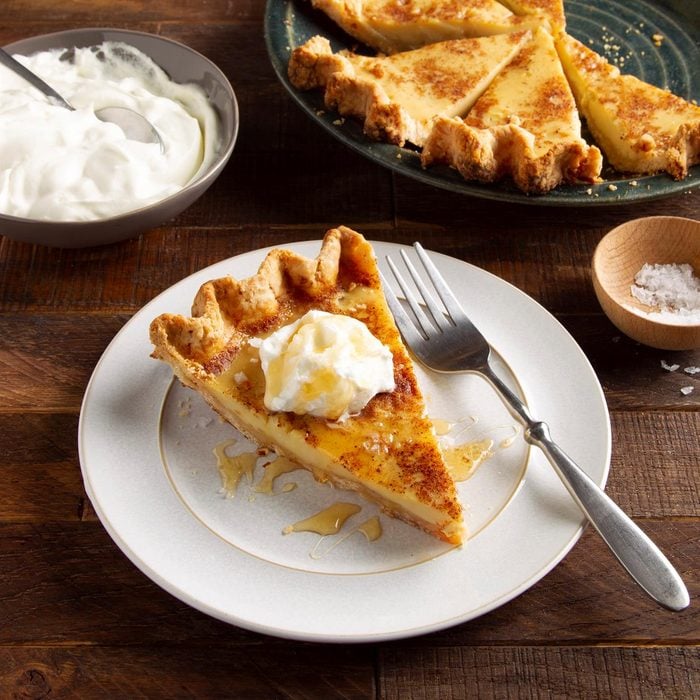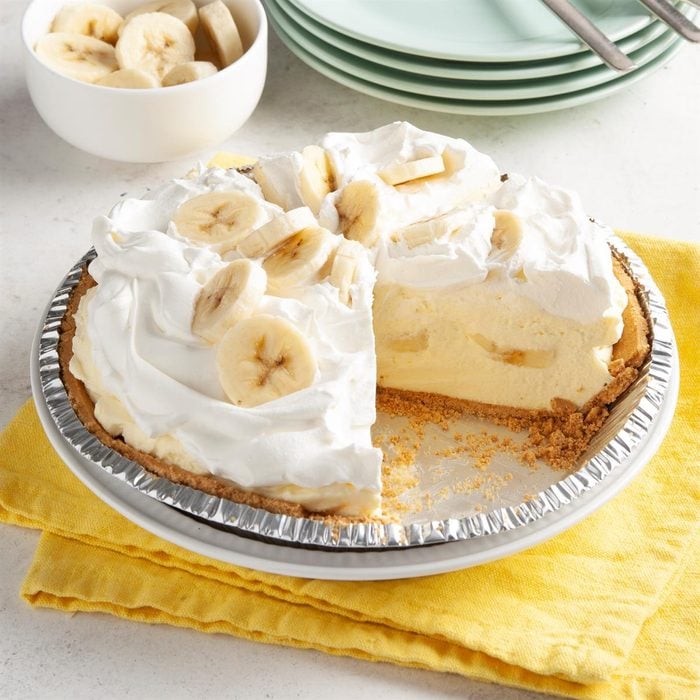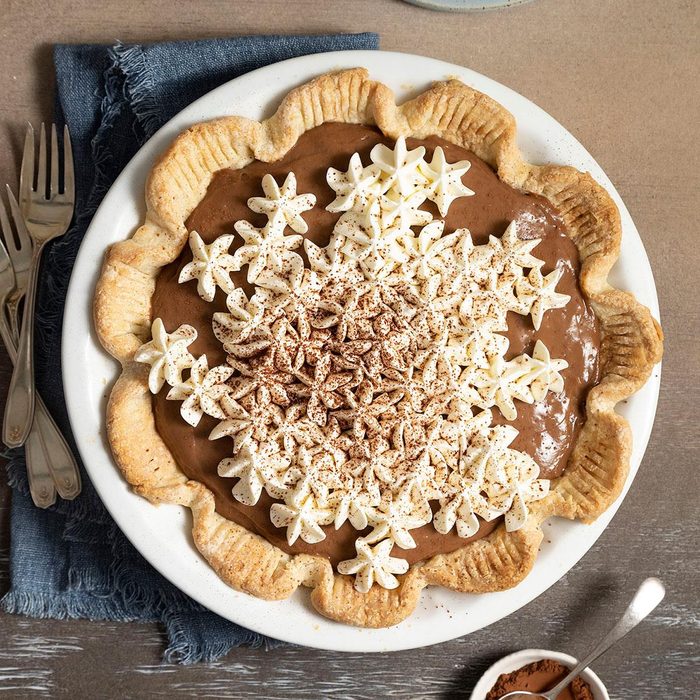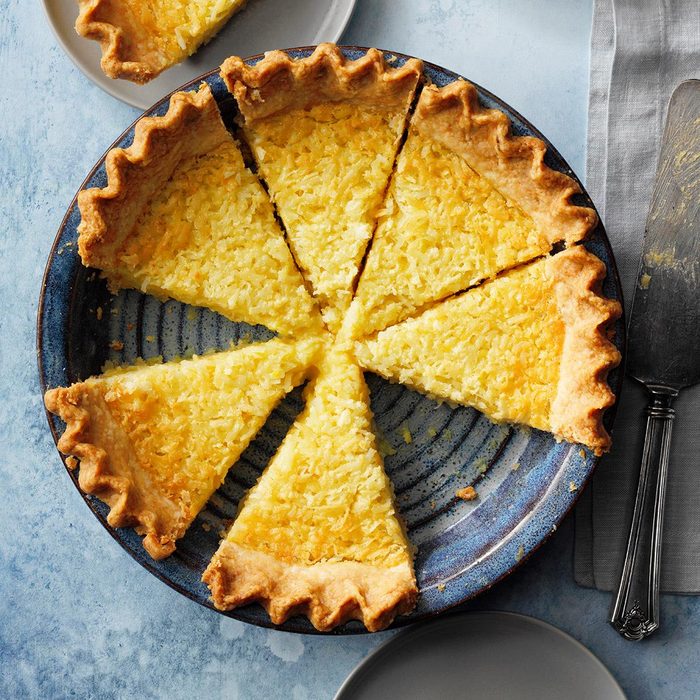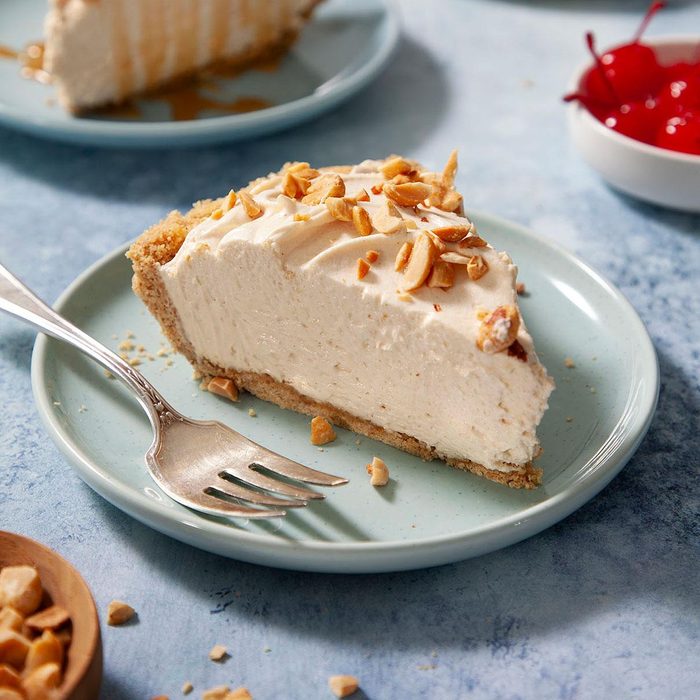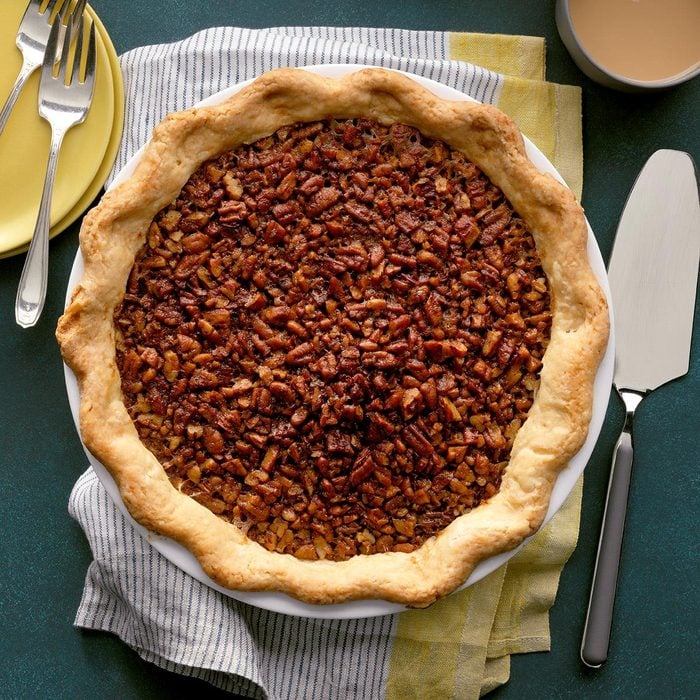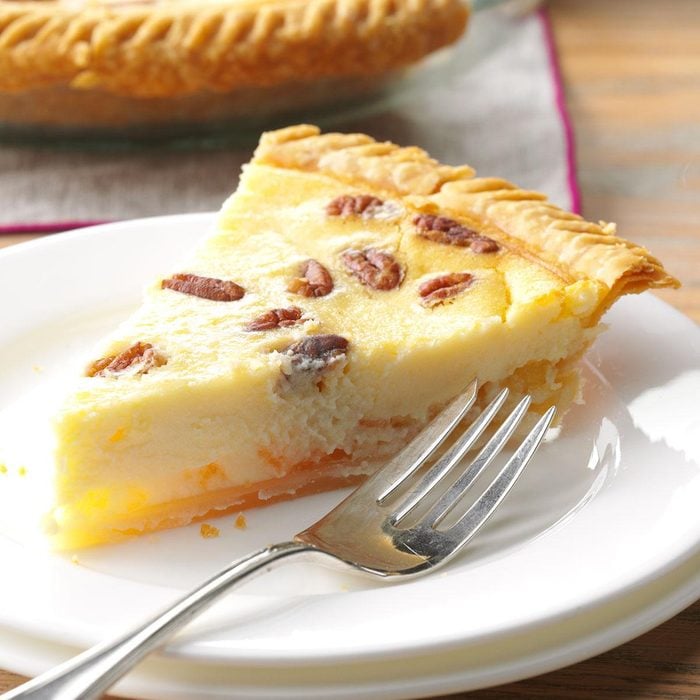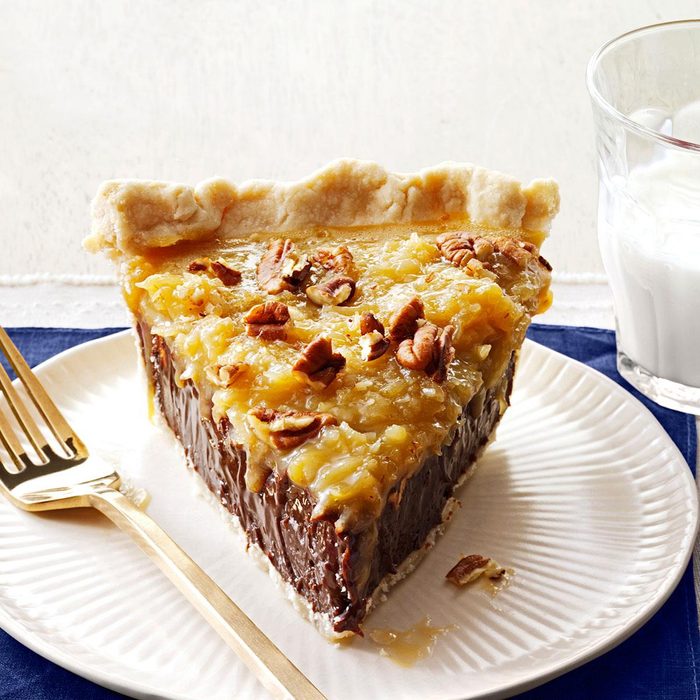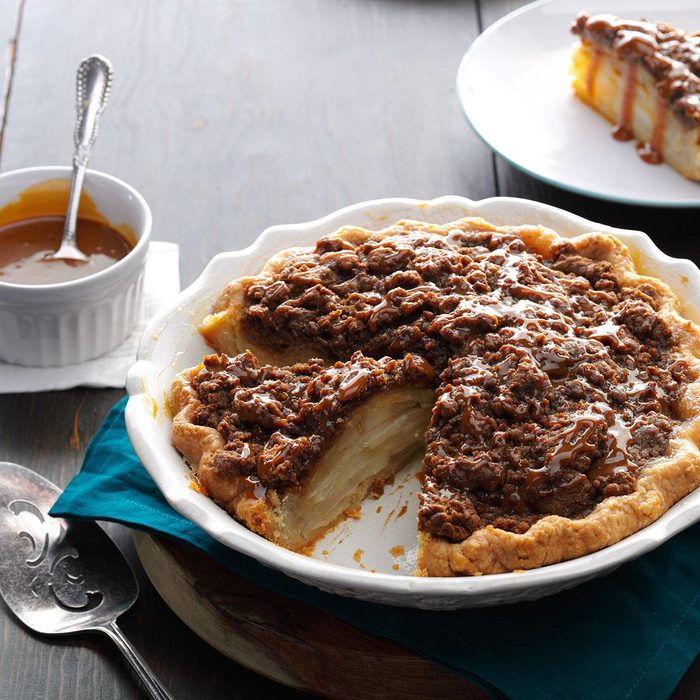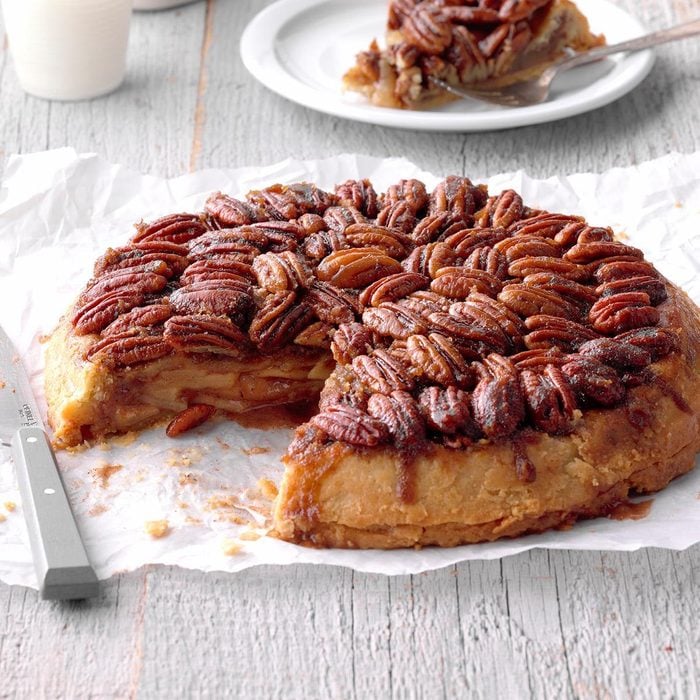Made with roasted chestnuts and cherries macerated in rum, Nesselrode pie is a cozy, nostalgic holiday treat you may remember from childhood.
Popular beginning around the 1940s at many New York City restaurants and diners, it all but disappeared in the 1960s. But it may be making a comeback. Petra “Petee” Paredez, owner of the popular New York City bakery Petee’s Pie Company, developed a Nesselrode pie recipe that’s featured in her recent cookbook, Pie for Everyone (one of our must-have cookbooks for 2020). Here’s how to whip up your own version of this classic, seasonal dessert.
What Is Nesselrode Pie?
Nesselrode pie is a chilled, creamy pie traditionally made with roasted chestnuts, candied fruit, and rum or brandy. But this vintage dessert has taken many forms throughout its history.
As Petra writes in her cookbook, the flavor combination first emerged as an iced pudding named for Karl von Nesselrode, a Russian count whose chef prepared the decadent dessert for him in the era before refrigeration. For decades, it was popular across Europe and eventually, in New York City.
New York City baker Hortense Spier is credited with first turning Nesselrode pudding into a pie, and it took off after a 1945 New York Times feature. With its ubiquity came variations. By the 1960s, many versions were rum-flavored chiffon pies topped with whipped cream, maraschino cherries and chocolate shavings—no chestnuts to be found.
In creating her version of Nesselrode pie, Petra says she tried to preserve the original flavors of Nesselrode pudding while also appealing to customers who fondly remember the versions they savored as kids in New York City diners.
How to Make Nesselrode Pie
This recipe comes from Paredez’s cookbook, Pie for Everyone. Made with gelatin and meringue, it has a light, airy filling inside of a flaky, buttery pie crust. “It’s really a vintage texture as well as a vintage flavor,” Petra says.
This recipe makes two pies because as Petra says, “It is such a labor of love, so if you’re doing one, you might as well do two.”
Ingredients
For the chestnut puree:
- 1/2 cup shelled, peeled chestnuts
- 2 tablespoons sugar
- 1 tablespoon rum
For the filling:
- 1/2 cup plus 2/3 cup sugar
- 2 tablespoons gelatin
- 1/2 teaspoon salt
- 6 eggs, separated
- 1-1/2 cups heavy cream
- 2-1/2 cups whole milk
- 3 tablespoons dark rum
- 1 teaspoon vanilla
For the assembly:
Editor’s note: Pie for Everyone includes Paredez’s recipes for homemade pie crusts, macerated cherries, chocolate ganache and vanilla whipped cream. In the interest of space, we’ve linked to our versions of these recipes. You can also use store-bought products in many cases.
What You’ll Need to Make Nesselrode Pie
- Petra’s cookbook: Nesselrode pie is just one of many amazing pie recipes from Petee’s Pie Company. Snag the book to get full details on Nesselrode pie and plenty of other delicious treats.
- Luxardo Maraschino cherries: Trust us on this one: You want to go for this luscious brand if you don’t make your own macerated cherries.
- Hand mixer: To get airy meringue and whipped cream, you’ll want an electric mixer to do the job.
Directions
Step 1: Make the chestnut puree
Pulse the chestnuts and sugar in a food processor to combine. While the machine is running, add the rum and process for about two minutes, stopping every 30 seconds to scrape the sides of the bowl. The puree should be smooth, not grainy.
Editor’s tip: To skip the time-intensive process of shelling and peeling, use store-bought roasted and peeled chestnuts. If you want to use fresh ones, here’s how to roast and peel chestnuts yourself.
Step 2: Prepare the chestnut custard
Place a medium mixing bowl in the freezer to chill. In the meantime, combine the gelatin, salt and 1/2 cup of sugar in a large saucepan. Whisk in the egg yolks and then the chestnut puree. Slowly whisk in the cream and then the milk. Cook over medium heat, stirring constantly and scraping the bottom of the pan with a rubber spatula.
When the mixture reaches 180°F on a candy thermometer, remove it from the heat and immediately pour it into the chilled mixing bowl. Stir in the rum. Refrigerate for about 40 minutes, stirring every 10 minutes, until chilled and thickened.
Step 3: Whip up the meringue
Start this step by making a simple syrup. In a saucepan, combine the remaining 2/3 cup of sugar and 3 tablespoons of water. Cook over medium heat, stirring until the sugar has dissolved and the syrup starts to bubble. Turn off the heat.
Next, use a stand mixer or hand-held mixer with the whisk attachment to beat the egg whites until soft peaks form. While the mixer is still running, pour in the hot sugar syrup and vanilla. Stop mixing when the meringue holds medium-stiff peaks but is still silky, not foamy.
Editor’s tip: Petra emphasizes that it’s important to avoid over-whipping the meringue. “You want it to be somewhat pliable still,” she says. This silky consistency will allow you to fold the meringue into the custard without the egg whites separating.
Step 4: Combine the filling
Transfer about 3/4 of the meringue into a separate bowl, leaving the rest in the mixer bowl or on the whisk attachment. Pour the chestnut custard into the mixer bowl and beat it with the remaining meringue until smooth. Remove the bowl from the mixer and gently fold in the rest of the meringue.
Step 5: Assemble and chill the pies
Pour a heaping cup of filling into each of the pie crusts and use a spatula to spread it around the bottom of the pie shell. (Here’s how to make perfect flaky pie crusts.) Fold the cherries into the remaining filling and use the mixture to finish filling the pies. Spread the filling to the edge of each pie crust and mound it slightly in the center. Refrigerate for four hours or until the filling sets.
Editor’s tip: Paredez uses macerated cherries that she makes with rum and fresh sour cherries, but you can use store-bought maraschino cherries. Paredez recommends using high-quality ones like Luxardo maraschino cherries but adds that the more affordable, neon ones that are readily available at grocery stores may add to this recipe’s 1960s nostalgia.
Step 6: Add toppings
Once the filling is set, it’s time to add toppings. The recipe in Paredez’s book uses chocolate ganache, but many Nesselrode pies were topped with chocolate shavings.
- If topping with chocolate ganache: Transfer the warm ganache (here’s how to make chocolate ganache) into a pastry bag with a narrow tip and pipe it over the pies in a crisscross pattern. Transfer the whipped cream into another pastry bag fitted with a round tip and pipe it around the edges of each pie. Top with additional cherries.
- If topping with chocolate shavings: Sprinkle the shavings over the pies, then top with whipped cream and additional cherries.
Editor’s tip: Here’s how to use a piping bag like a pro. But if you’re in a pinch, you can apply frosting with a Ziploc bag.
Step 7: Serve
To preserve the pie’s height and fluffiness, slice it with a sharp knife dipped in hot water. Because of its delicate texture, Nesselrode pie is best enjoyed immediately, Petra says. However, it will keep in the refrigerator (covered) for up to two days.
More Vintage Pie Recipes
Grandma’s Chocolate Meringue PieMy grandmother served this old-fashioned chocolate pie recipe after Sunday dinner each week, usually with an apology it was "too runny" or something else was wrong with it. Of course, grandma's chocolate pie was never less than perfect! – Donna Vest Tilley, Chesterfield, Virginia
Fresh Cherry PieIf you're looking to learn how to make a cherry pie, this recipe is the place to start. This ruby-red cherry pie is just sweet enough, with a hint of almond flavor and a good level of cinnamon. The cherries peeking out of the lattice crust makes it so pretty, too. I like to make a few of these cherry pies throughout the summer. —Josie Bochek, Sturgeon Bay, Wisconsin
Maple Syrup PieFolks in New Hampshire apparently appreciate maple syrup almost as much as we do in Vermont. When my husband and I took a road trip through New Hampshire, we discovered this pie at a number of diners and restaurants. We loved it so much we created our own version. —Laurie Herr, Westford, Vermont
Mom’s Peach PieA delightful summertime pie, this vintage dessert is overflowing with fresh peach flavor. Each sweet slice is packed with old-fashioned appeal. The streusel topping makes this pie a little different than the ordinary and adds homemade flair. —Sally Holbrook, Pasadena, California
Green Tomato PieWhen frost nips our garden, I quickly gather all the green tomatoes still on the vine and make this old family favorite. It's been handed down from my grandmother, and now my granddaughters are asking for the recipe.—Violet Thompson, Port Ludlow, Washington
World’s Best Lemon PieMother's pies were always so wonderful, with tender, flaky crusts. Through the year we enjoyed berry and apple pies, but in summer the order of the day was this lemon pie recipe—so light and refreshing! —Phyllis Kirsling, Junction City, Wisconsin
Possum PieWe found this Possum Pie recipe in a recipe box from the previous cafe owner. It's been on our menu ever since. —David Heilemann, Eureka Springs, Arkansas
Strawberry Crumble PieI host an annual pie-making party before Labor Day. We host a pig roast on our farm every year, but the pies take center stage at the end of the meal. —Beth Howard, Donnellson, Iowa
Grandma’s Sour Cream Raisin PieThe aroma of this pie baking in my farm kitchen oven reminds me of my dear grandma who made this pretty pie for special occasions. —Beverly Medalen, Willow City, North Dakota
Cranberry Walnut PieHere’s a wonderful vintage dessert for Thanksgiving. With ruby-red color and a golden lattice crust, this pie looks as good as it tastes. —Diane Everett, Dunkirk, New York
Irresistible Coconut Cream PieMy husband and I grow 500 acres of wheat on the farm his family homesteaded in 1889. I grind my own flour and love to use it in this recipe. The easy, pat-in crust has a rich grain flavor. It’s irresistible filled with old-fashioned coconut cream and topped with a fluffy meringue. —Roberta Foster, Kingfisher, Oklahoma
Orchard Pear PieI made this pie using Bartlett pears fresh from the orchard. It's a lovely dessert to include in your holiday menu. You can also use canned pears if fresh are not available. —Mary Anne Thygesen, Portland, Oregon
Grandma Pruit's Vinegar PieThis historic pie has been in our family for many generations and is always served at our get-togethers.—Suzette Pruit, Houston, Texas
Apple PieBaking apple pie from scratch is a fall baking tradition we treasure. Perfect your technique with our apple pie recipe, full of all the tips and tricks you’ll need.
Check out how this
soft pretzel pie crust transforms apple pie!
Shoofly PieShoofly pie is a classic Pennsylvania Dutch dessert with a sweet, gooey filling and a crunchy brown sugar topping.
Bread Pudding PieThis unique dessert is a bread pudding-pie combo. It was created by my paternal grandmother's family. They had a farm and made their own bread, which made this a low-cost dessert. — Kelly Barnes, Lexington, Indiana
Oregon’s Best Marionberry PieI believe Oregon marionberries make about the best berry pie in the world. And when you add some cream cheese and flavorings, you'll be making the best even better! —Frances Benthin, Scio, Oregon
Mom-Mom Bessie’s Coconut Molasses PieI'm the keeper of my husband's grandmother's handwritten recipe book. Mom-Mom Bessie was one of the best cooks I knew, and we think of her every time we make this vintage pie. The flavor combination of coconut and molasses is a family favorite. —Susan Bickta, Kutztown, Pennsylvania
Mixed Berry PieOur berry pie is the best way to use up those beautiful summer berries. Colorful, juicy berries are tucked into a homemade all-butter pie crust that dares not get a soggy bottom and stays perfectly flaky all the way through.
Creamy Chocolate-Banana PieYou can make almost any dessert more awesome with chocolate. In this cream pie, fresh banana and chocolate make a truly irresistible combo.
—Diane Nemitz, Ludington, Michigan
Walnut Mincemeat PieAs a cold and tasty finishing touch, my husband and I usually put a dip of ice cream on top of our mincemeat pie slices. The recipe comes from my mother. Each year, I make it for Christmas and for my sister-in-law's New Year's party. —Laverne Kamp, Kutztown, Pennsylvania
Grapefruit Meringue PieThere's a grapefruit tree in our backyard, so I like to use fresh grapefruit juice when I make this pie. I just love the unique citrus flavor of this dessert. —Barbara Soliday, Winter Haven, Florida
Mixed Berry PieOur berry pie is the best way to use up those beautiful summer berries. Colorful, juicy berries are tucked into a homemade all-butter pie crust that dares not get a soggy bottom and stays perfectly flaky all the way through.
Old-Time Buttermilk PieMy mother and grandmother made this pie with buttermilk and eggs from our farm and set it on the tables at church meetings and social gatherings. I did the same, and now our children make it too! —Kate Mathews, Shreveport, Louisiana
Granny’s Rhubarb PieThis recipe originated with my grandmother, who baked many different rhubarb desserts. This vintage pie was always a favorite of mine. —Blanche Baninski Minto North Dakota
Honey PieA hint of honey flavors this old-fashioned honey custard pie that comes together quickly with simple ingredients. Don't be afraid of blind-baking the crust, it's easy to do. —
Taste of Home Test Kitchen
The best pies start with the best crusts. Learn how to blind-bake pie crust from scratch using step-by-step instructions.
Purple Plum PieI can never resist a tempting slice of this beautiful plum pie. It's a down-home dessert that makes any meal special. This pie is a terrific way to put bountiful summer plums to use. —Michelle Beran, Claflin, Kansas
Old-Fashioned Banana Cream PieThis old-fashioned banana cream pie recipe is full of flavor. Because it uses instant pudding, this no-bake dessert is ready in just minutes. —Perlene Hoekema, Lynden, Washington
Chocolate Cream PieWith a shortened baking window for the crust and a quickly cooked filling, our chocolate cream pie comes together with minimal hands-on time.
Special Raisin PieWhen I first made this pie, I thought it was great. Then I entered it at the county fair and I guess the judges thought it was great, too, since it won first place. —Laura Fall-Sutton, Buhl, Idaho
Contest-Winning Fresh Blueberry PieI've been making this blueberry pie recipe for decades since the ingredients for the filling are readily available in Michigan. Nothing says summer like a piece of fresh blueberry pie! —Linda Kernan, Mason, Michigan
Mama’s Buttermilk Coconut PieMy mama showed me how to make this vintage pie about 40 years ago, just as her mama showed her how to make it. I was 6 when Mawmaw passed away, but I can still remember her cooking in the kitchen in her beautiful cotton dresses dusted with flour. I am honored to teach my daughter how to make this dessert, too. —Lisa Allen, Joppa, Alabama
Peanut Butter Cream PieIt's nice to have a fluffy, no-bake dessert that's a snap to make. Packed with peanut flavor, this pie gets gobbled up even after a big meal! —Jesse & Anne Foust, Bluefield, West Virginia
Grasshopper PieI only need six ingredients to whip up this fluffy and refreshing grasshopper pie. I usually make two of the minty treats for our family, since we're never satisfied with just one slice. —LouCinda Zacharias, Spooner, Wisconsin
The Best Pecan PiePecan pie is a Thanksgiving tradition in my house, and I was on a quest to create the ultimate version. This might be it!—James Schend,
Taste of Home Deputy Editor
Cream Cheese-Pineapple PieI've made this pie many times for friends, relatives, guests, church suppers and bazaars, and I'm always getting requests for the recipe. I've lived on farms all my life—we used to have a potato farm on Long Island, and now my son farms his own land and manages mine here in Delaware, growing soybeans and wheat. —Elizabeth Brown, Clayton, Delaware
Coconut-Pecan German Chocolate PieThis German chocolate pecan pie combines the ingredients everyone loves in its classic cake cousin. It's so silky and smooth, you won't be able to put your fork down. —Anna Jones, Coppell, Texas
Gingersnap Crumb Pear PieThis basic recipe was one my grandmother used for making crumble pies from fresh fruit. She simply substituted oats, gingersnaps or vanilla wafers depending on the fruit. Pear was always my favorite, and I added the ginger and caramel to give it a new twist. —Fay Moreland, Wichita Falls, Texas
French Silk PieI first made French silk pie when I was in high school. Years later, I tinkered with the recipe until I was happy with it. Now it’s one of my husband's favorites. —Lisa Francis, Elba, Alabama
Peanut Butter Cream PieDuring the warm months, it's nice to have this fluffy, no-bake peanut butter pie that's a snap to make. Packed with flavor, this pie gets gobbled up even after a big meal! —Jesse & Anne Foust, Bluefield, West Virginia
Spiced Upside-Down Apple PieMy grandma taught me to make this pie when I was 4. Over the years, I've kept it about the same with just a few changes. Flip it out the second it stops bubbling. The glaze makes it look especially delicious. —Francine Bryson, Pickens, South Carolina























